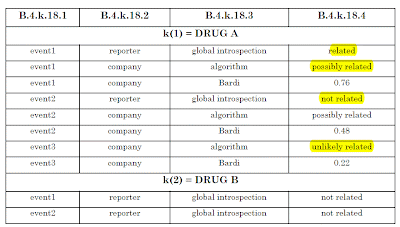When
we conduct a clinical trial using an approved product, we may run into the
requests for the list of common, very common adverse events. This may be
especially true when the clinical trials are conducted in European countries.
The requests may come from the IRB (institutional review board) or EC (ethics
committee).
Breaking
down the AEs into very common, common, uncommon, rare, and very rare categories
is part of the requirements for SmPC (product label in EU countries). The
requirements are included in various EC or EMA guidelines
A
GUIDELINE ON SUMMARY OF PRODUCT CHARACTERISTICS (2005) stated:
Within each system organ class, the ADRs should be ranked under headings of frequency, most frequent reactions first, using the following convention:
Very common (greater than and equal to 1/10); common (greater than and equal to 1/100 to less than 1/10); uncommon (greater than and equal to 1/1,000 to less than 1/100); rare (greater than and equal to 1/10,000 to less than 1/1,000); very rare (less than and equal to 1/10,000), not known (cannot be estimated form the available data).
Within each system organ class, the adverse reactions should be ranked under headings of frequency, most frequent reactions first. Within each frequency grouping, adverse reactions should be presented in the order of decreasing seriousness. The names used to describe each of the frequency groupings should follow standard terms established in each official language using the following convention: Very common (≥1/10); common (≥1/100 to <1/10); uncommon (≥1/1,000 to <1/100); rare (≥1/10,000 to <1/1,000); very rare (<1/10,000).
An EMA presentation specifically
discussed what the Section
4.8: Undesirable effects should include in terms of quantifying the adverse
drug reactions.
There are plenty of
examples for showing how the adverse drug reaction tables in Summary of Product
Characteristics should be presented.
- Cimzia 200 mg solution for injection
- Avastin 25 mg/ml concentrate for solution for infusion.
- Example SmPC - European Medicines Agency - Europa
In
the recent issued EMA
guidance for Fibrin Sealant, it also requires to breakdown the AEs into the
following categories:
Tabulated
list of adverse reactions
The
table presented below is according to the MedDRA system organ classification
(SOC and Preferred 265 Term Level).
Frequencies
have been evaluated according to the following convention: Very common (greater than and equal to 1/10);
common (greater than and equal to 1/100
to less than 1/10); uncommon (greater than and equal to 1/1,000 to less than 1/100); rare (greater than and equal to 1/10,000 to less than 1/1,000); very rare (less than 1/10,000), not known (cannot be estimated from the
available data).
The source for the
quantification of risk for adverse reactions is the CIOMS. For example, Benefit-Risk
Balance for Marketed Drugs: Evaluating Safety Signals Report of CIOMS
Working Group IV has a section for “quantification of risk”
5. Quantification of Risk Incidence of the reaction
To put the newly identified risk into perspective, it is important to quantify it in terms of incidence. Precise quantification will usually be difficult in the post-marketing environment, in which most new safety signals arise from spontaneous reporting, with its associated uncertainties as to numerators (reported cases) and denominators (patient exposures). However, risk can often be approximated in terms of magnitudes of 10, as suggested in the CIOMS III report: greater than 1% (common or frequent); greater than 1 per 1000 but less than 1 per cent (uncommon or infrequent); greater than 1 per 10,000 but less than 1 per 1000 (rare); less than 1 per 10,000 (very rare).
When possible, attempts should be made to determine whether the incidence is affected by the existence of any apparent high-risk groups. These might be defined by, for example, dose or duration of treatment, use of other drugs (e.g., drug interactions), presence of other diseases (e.g., renal failure), or special populations defined by demographics or ethnicity. In principle, one of the most important functions of risk evaluation is to identify individual patients at increased risk of serious adverse reactions. Although some mechanisms are fairly well understood (enzyme inhibition processes; drug interactions), the pharmacological and biological basis of drug-induced diseases (e.g., role of pharmacogenetics) is relatively unexplored. Work in this area is needed and should be encouraged.
In US, when we prepare the summary tables for adverse events or adverse drug reactions, we typically don’t include a table to break down the frequency into very common, common, uncommon, rare and very rare categories. The drug label did not require to include the quantification of risk using these categories. However, for drug to be approved in European countries, it is a good idea to include a summary table with these quantification categories.

